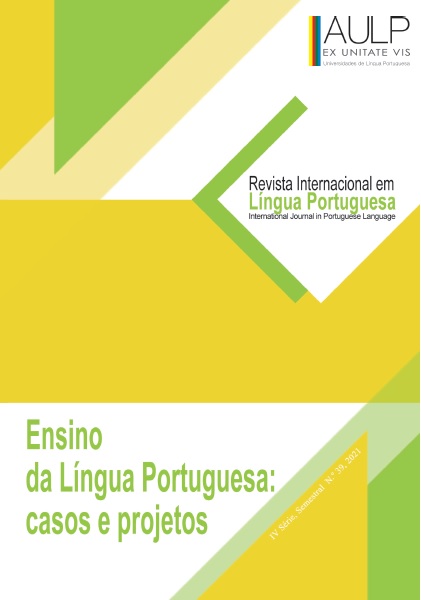Review of four manuals currently available for the teaching Portuguese as a foreign language
Main Article Content
Keywords
textbooks; portuguese as a foreign language; teaching methodologies; communicative competence.
Abstract
Despite the new technological resources for teaching foreign languages, the textbook is still a privileged instrument; it guides the contents of the syllabus, the competences to be developed, and allows to monitor the progress of learning. Textbooks have acquired new responsibilities for their users. The times, challenges and demands have changed. Teaching language content is not enough. A textbook has to be a facilitator of the skills development and its choice should be cautious. Four teaching Portuguese as foreign language textbooks have been analyzed, and it is observed that they all emphasize the study of grammar and present different activities concerning communication development skills, being more engaged with new pedagogical approaches, therefore more attractive. However, one may clearly notice that they still keep a traditional plan and layout and do not consider the use of new technologies.
References
Baptista, L., Costa, J., Madeira, A., Resende, J., e Pereira, A. P. (2007). Projecto “Políticas e práticas de internacionalização do ensino da língua portuguesa: os leitorados de português”. Lisboa: Faculdade de Ciências Sociais e Humanas da Universidade Nova de Lisboa.
Brown, G., e Yule, G. (1983). Teaching the spoken language. Cambridge: Cambridge University Press.
Brown, H. D. (2001). Teaching by principles: an interactive approach to language pedagogy (2.ª ed.). White Plains, NY: Longman.
Brumfit, C. J. (1980). Seven last slogans. Modern English Teacher, 7(1), 30-31.
Canale, M., e Swain, M. (1980). Theoretical basis of communicative approaches to second language teaching and testing. Applied Linguistics, 1(1), 1-47.
Castro, R. V. (1999). Já agora não se pode exterminá-los?, sobre a representação dos professores em manuais escolares de português. Em R. V. Castro, A. Rodrigues, e J. L. Silva (Eds.), Actas – Manuais Escolares – estatuto, funções, história, (pp. 189-196). Braga: Instituto de Educação e
Psicologia, Universidade do Minho.
Celce-Murcia, M., e Larsen-Freeman, D. (1999). The grammar book: an ESL/EFL teacher’s course (2.ª ed.). Boston: Heinle and Heinle.
Council of Europe. (2001). Common European framework of reference for languages: learning, teaching and assessment. Cambridge: Cambridge University Press.
Cunningsworth, A. (1979). Evaluating course materials. Em S. Holden (Ed.), Teacher training (pp. 31-33). Hong Kong: Modern English Publications.
Cunningsworth, A. (1987). Coursebooks and conversational skills. Em L. E. Sheldon (Ed.), ELT textbooks and materials: problems in evaluation and development (pp. 45-54). Oxford: Modern English Publications/The British Council.
Cunningsworth, A. (1995). Choosing your coursebook. Oxford: Macmillan Heineman.
Ellis, R. (1997). The empirical evaluation of language teaching materials. ELT Journal, 51(1), 36-42.
Ellis, R. (2002). The place of grammar instruction in the second/foreign language curriculum. Em E. Hinkel e S. Fotos (Eds.), New perspectives on grammar teaching in second language classrooms(pp. 17-34). London: Routledge.
Ellis, R. (2014). Taking the critics to task: the case for task-based teaching. The Sixth CLS International Conference: Knowledge, skills and competencies in foreign language education (pp. 103-117). Singapura: NUS, Center for Language Studies.
Gilmore, A. (2008). Authentic materials and authenticity in foreign language learning. Language Teaching, 40, 97-118.
Hutchinson, T., e Waters, A. (1987). English for specific purposes: a learning-centered approach. Cambridge: Cambridge University Press.
Krashen, S. (2004, abril). Free voluntary reading: research, applications, and controversies. Comunicação apresentada na conferência RELC, Singapura.
Larsen-Freeman, D. (1997). Chaos/ complexity science and second language acquisition. Applied Linguistics, 18(2), 141-165.
Larsen-Freeman, D. (2014). Teaching grammar. Em M. Celce-Murcia, D. M. Brinton, e M. A. Snow (Eds.), Teaching English as a second or foreign language (pp. 256-270). Boston: Heinle Cengage Learning.
McDonough, J., e Shaw, C. (2003). Materials and methods in ELT (2.ª ed.). Maine: Blackwell Publishing.
McDonough, J., Shaw, C., e Masuhara, H. (2013). Materials and methods in ELT: a teacher’s guide (3.ª ed.). Maine: Blackwell Publishing.
McGrath, I. (2002). Materials evaluation and design for language teaching. Edinburg: Edinburg University Press.
Mishan, F. (2013). Modes of delivery. Em B. Tomlinson (Ed.), Applied linguistics and materials development (pp. 287-301). London: Bloomsbury.
Nunan, D. (1988). Syllabus design. Oxford: Oxford University Press.
Nunan, D. (1991). Communicative task and language curriculum. TESOL Quarterly, 25(2), 279-295.
Nunan, D. (1998). Language Teaching Methodology. London: International Books Distributors Ltd.
Sheldon, L. E. (1988). Evaluating ELT textbooks and materials. ELT Journal, 42(4), 237-246.
Slaouti, D. (2013). Technology in ELT. Em J. McDonough, C. Shaw, e H. Masuhara (Eds.), Materials and methods in ELT (pp. 79-105). Malden: Wiley-Blackwell.
Swan, M. (1985). A critical look at the communicative approach (1). ELT Journal, 39(1), 2-12.
Swan, M. (2005). Legislation by hypothesis: the case of task-based instruction. Applied Linguistics, 26(3), 376-401.
Thompson, G. (1996). Some misconceptions about communicative language teaching. ELT Journal, 50(1), 9-15.
Tomlinson, B. (1998). Materials development in language teaching. Cambridge: Cambridge University Press.
Tomlinson, B. (2010). Language acquisition and language learning materials. Em B. Tomlinson (Ed.), English Language Learning Materials: a critical. London: Continuum International Publishing Group.
Tomlinson, B. (2011). Material development in language teaching (2.ª ed.). Cambridge: Cambridge University Press.
Tomlinson, B. (2012). Materials development for language learning and teaching. Language Teaching, 45(2), 1-37.
Tomlinson, B. (2013). Introduction: applied linguistics and materials development. Em B. Tomlinson (Ed.), Applied linguistics and materials development (pp. 1-7). London: Bloomsbury.
Waring, R. (2006). Why extensive reading should be an indispensable part of all language programs. The Language Teacher, 30(7), 44-47.
Widdowson, H. G. (1978). Teaching language as communication. Oxford: Oxford University Press.
Widdowson, H. G. (1998). Context, community, and authentic language. TESOL Quarterly, 32(4), 705–716.
Wilkins, D. A. (1972). Linguistics in language teaching. London: Edward Arnold.
Williams, D. (1983). Developing criteria for textbook evaluation. ELT Journal, 37(3), 251-255.
Wray, A. (2000). Formulaic sequences in second language teaching: principle and practice. Applied Linguistics, 21(4), 463–489.


